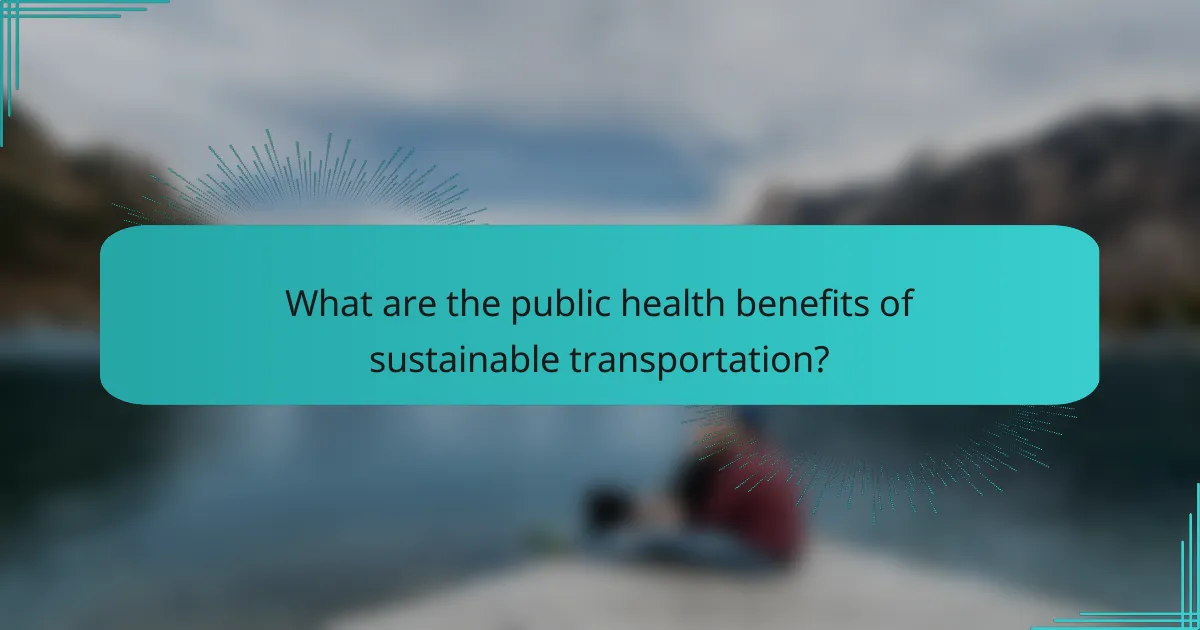Sustainable transportation options play a crucial role in reducing emissions and promoting public health while enhancing accessibility for all. By embracing alternatives such as electric vehicles, cycling, and efficient public transit systems, communities can improve air quality and encourage active lifestyles. These initiatives not only contribute to a cleaner environment but also foster a healthier population and lower healthcare costs.

What are the sustainable transportation options in Australia?
Sustainable transportation options in Australia include electric vehicles, bicycles, public transit systems, carpooling services, and improved walking infrastructure. These alternatives aim to reduce emissions, enhance public health, and increase accessibility across urban and rural areas.
Electric vehicles
Electric vehicles (EVs) are gaining popularity in Australia as a sustainable transport option. They produce zero tailpipe emissions, significantly reducing air pollution compared to traditional petrol or diesel cars. Many Australian states offer incentives for EV purchases, such as rebates and tax exemptions.
When considering an EV, look for models with a good range, typically between 250 to 500 kilometers on a single charge. Charging infrastructure is expanding, with many public charging stations available, making it easier to transition to electric driving.
Bicycles and e-bikes
Bicycles and e-bikes are effective and eco-friendly modes of transport that promote physical health while reducing emissions. In urban areas, dedicated bike lanes and bike-sharing programs enhance accessibility and safety for cyclists.
For commuting, e-bikes can be particularly beneficial, allowing riders to cover longer distances without excessive exertion. Many Australian cities have invested in cycling infrastructure, making it easier for residents to choose biking as a primary mode of transport.
Public transit systems
Public transit systems in Australia, including buses, trains, and trams, offer a sustainable alternative to private vehicle use. These systems are designed to reduce traffic congestion and lower overall emissions by transporting multiple passengers at once.
Investing in public transit can lead to significant health benefits by decreasing air pollution and promoting active commuting, such as walking to transit stops. Many cities have integrated ticketing systems, making it easier for users to navigate various modes of transport seamlessly.
Carpooling services
Carpooling services allow individuals to share rides, reducing the number of vehicles on the road and lowering emissions. Platforms for carpooling are increasingly popular in Australia, connecting drivers with passengers heading in the same direction.
Using carpooling can save money on fuel and parking costs while fostering community connections. It’s essential to choose reputable services and ensure safety measures are in place, such as verifying user profiles and maintaining communication throughout the journey.
Walking infrastructure
Walking infrastructure, such as sidewalks, pedestrian crossings, and green spaces, is crucial for promoting sustainable transportation. Well-designed walking paths encourage people to choose walking over driving, contributing to reduced emissions and improved public health.
Australian cities are increasingly focusing on enhancing walkability by creating pedestrian-friendly zones and improving connectivity between neighborhoods. Investing in walking infrastructure not only benefits the environment but also supports local businesses by increasing foot traffic.

How do sustainable transportation options reduce emissions?
Sustainable transportation options significantly reduce emissions by promoting eco-friendly practices and technologies. These methods, such as public transit, cycling, and electric vehicles, help lower greenhouse gas output and contribute to cleaner air quality.
Lower carbon footprint
Sustainable transportation options typically have a lower carbon footprint compared to traditional vehicles. For instance, electric cars produce zero tailpipe emissions, while public transport systems can carry many passengers at once, reducing the per-person emissions significantly.
Choosing to walk or bike for short trips can further minimize individual carbon footprints. Studies suggest that shifting just a portion of car trips to these alternatives can lead to substantial reductions in overall emissions.
Use of renewable energy sources
Many sustainable transportation systems utilize renewable energy sources, such as solar or wind power, to operate. Electric buses and trains can be powered by electricity generated from these clean sources, further decreasing reliance on fossil fuels.
Incorporating renewable energy not only reduces emissions but also enhances energy security. Regions investing in solar-powered charging stations for electric vehicles are setting a precedent for sustainable energy use in transportation.
Reduced traffic congestion
Sustainable transportation options can alleviate traffic congestion, which is a significant contributor to emissions. By encouraging public transit use, carpooling, and cycling, cities can reduce the number of vehicles on the road, leading to less idling and lower emissions overall.
Implementing dedicated bike lanes and improving public transport infrastructure can encourage more people to opt for these alternatives. Cities that have invested in such infrastructure often report improved air quality and reduced travel times for all road users.

What are the public health benefits of sustainable transportation?
Sustainable transportation offers significant public health benefits by reducing emissions, improving air quality, and promoting active lifestyles. These advantages contribute to overall community well-being and can lead to lower healthcare costs and enhanced quality of life.
Improved air quality
One of the primary public health benefits of sustainable transportation is improved air quality. By reducing reliance on fossil fuel-powered vehicles, cities can lower levels of harmful pollutants such as nitrogen oxides and particulate matter. This leads to fewer respiratory issues and cardiovascular diseases among residents.
For instance, cities that promote cycling, walking, and public transit often see a marked decrease in air pollution levels. Implementing low-emission zones can further enhance air quality, benefiting vulnerable populations such as children and the elderly.
Increased physical activity
Sustainable transportation encourages increased physical activity, which is crucial for maintaining a healthy lifestyle. Walking, biking, and using public transport often require more movement than driving, contributing to higher daily activity levels. This can help combat obesity and related health issues.
Communities can support this by developing pedestrian-friendly infrastructure, such as sidewalks and bike lanes. Local governments can also organize events that promote active transportation, making it easier for residents to incorporate physical activity into their daily routines.
Reduced noise pollution
Another public health benefit of sustainable transportation is the reduction of noise pollution. Electric vehicles, bicycles, and public transit systems typically generate less noise than traditional cars and trucks. Lower noise levels can lead to improved mental health and reduced stress for community members.
Urban planning that prioritizes quiet zones and green spaces can further enhance this benefit. By creating environments that minimize noise, cities can foster a more peaceful atmosphere conducive to relaxation and social interaction.

How does accessibility improve with sustainable transportation?
Accessibility improves with sustainable transportation by ensuring that all individuals, regardless of mobility or socioeconomic status, can easily access transit options. This inclusivity not only enhances public health but also promotes a more equitable society.
Enhanced public transit access
Enhanced public transit access is crucial for connecting underserved communities to essential services and employment opportunities. Sustainable transportation options, such as electric buses and bike-sharing programs, often prioritize routes that serve low-income areas, reducing travel times and improving reliability.
For example, cities implementing dedicated bus lanes can significantly increase the frequency and speed of public transit, making it a more attractive option for daily commutes. This shift encourages more people to use public transit, leading to reduced traffic congestion and lower emissions.
Inclusive design for all users
Inclusive design in sustainable transportation focuses on creating systems that accommodate users of all abilities. This includes features like low-floor buses, tactile paving, and audible signals at crosswalks, which help individuals with disabilities navigate public spaces safely.
Implementing universal design principles ensures that transportation infrastructure is accessible to everyone, including the elderly and parents with strollers. Cities that embrace these designs often see increased ridership and community satisfaction.
Lower transportation costs
Lower transportation costs are a significant benefit of sustainable transportation options. Public transit systems typically offer affordable fares, often subsidized by local governments, making them a cost-effective choice for many residents.
Moreover, by reducing reliance on personal vehicles, individuals can save on expenses related to fuel, maintenance, and parking. For instance, using a monthly transit pass can cost significantly less than maintaining a car, especially in urban areas where parking fees can be high.

What criteria should be considered when choosing sustainable transportation?
When selecting sustainable transportation options, consider factors such as cost-effectiveness, emissions reduction, public health benefits, and accessibility. These criteria help ensure that the chosen methods are not only environmentally friendly but also practical and beneficial for communities.
Cost-effectiveness
Cost-effectiveness is a crucial criterion for sustainable transportation, as it evaluates the financial implications of different options. Public transit systems, cycling, and walking often present lower costs compared to personal vehicles, especially when factoring in fuel, maintenance, and parking expenses.
When assessing cost-effectiveness, consider the initial investment versus long-term savings. For example, electric vehicles may have higher upfront costs but can lead to significant savings on fuel and maintenance over time. Additionally, government incentives for electric vehicles or public transport can further enhance affordability.
To determine the most cost-effective option, calculate the total cost of ownership over a specific period, including insurance, fuel, and maintenance. Compare these figures across various transportation methods to identify the best value for your needs.


